Solutions
Exercise 1.1 Use software to produce the time series plot shown in Exhibit (1.2), page 2. The fol...
Exercise 1.2 Produce the time series plot displayed in Exhibit (1.3), page 3. Use the R code
Exercise 1.3 Simulate a completely random process of length 48 with independent, normal values. R...
Exercise 1.4 Simulate a completely random process of length 48 with independent, chi-square distr...
Exercise 1.5 Simulate a completely random process of length 48 with independent, t-distributed va...
Exercise 1.6 Construct a time series plot with monthly plotting symbols for the Dubuque temperatu...
Exercise 2.1 Suppose E(X) = 2, Var(X) = 9, E(Y) = 0, Var(Y) = 4, and Corr(X,Y) = 0.25. Find:
Exercise 2.2 If X and Y are dependent but Var(X) = Var(Y), find Cov(X + Y, X - Y).
Exercise 2.3 Let X have a distribution with mean m and variance s2 and let Yt = X for all t.
Exercise 2.4 Let {et} be a zero mean white noise processes. Suppose that the observed process is ...
Exercise 2.5 Suppose Yt = 5 + 2t + Xt where {Xt} is a zero mean stationary series with autocovari...
Exercise 2.6 Let {Xt} be a stationary time series and define
Exercise 2.7 Suppose that {Yt} is stationary with autocovariance function gk.
Exercise 2.8 Suppose that {Yt} is stationary with autocovariance function gk. Show that for any f...
Exercise 2.9 Suppose Yt = b0 + b1t + Xt where {Xt} is a zero mean stationary series with autocova...
Exercise 2.10 Let {Xt} be a zero-mean, unit-variance stationary process with autocorrelation func...
Exercise 2.11 Suppose Cov(Xt�,�Xt�-�k) = gk is free of t but that E(Xt) = 3t.
Exercise 2.12 Suppose that Yt = et - et�-�12. Show that {Yt} is stationary and that, for k > 0, i...
Exercise 2.13 Let . For this exercise, assume that the white noise series is normally distributed.
Exercise 2.14 Evaluate the mean and covariance function for each of the following processes. In e...
Exercise 2.15 Suppose that X is a random variable with zero mean. Define a time series by Yt�=�(-...
Exercise 2.16 Suppose Yt = A + Xt where {Xt} is stationary and A is random but independent of {Xt...
Exercise 2.17 Let {Yt} be stationary with autocovariance function gk. Let . Show that
Exercise 2.18 Let {Yt} be stationary with autocovariance function gk. Define the sample variance as
Exercise 2.19 Let Y1 = q0 + e1 and then for t > 1 define Yt recursively by Yt = q0 + Yt�-�1 + et....
Exercise 2.20 Consider the standard random walk model where Yt = Yt�-�1 + et with Y1 = e1.
Exercise 2.21 A random walk with random starting value. Let for t > 0 where Y0 has a distribution...
Exercise 2.22 Let {et} be a zero-mean white noise process and let c be a constant with |c| < 1. D...
Exercise 2.23 Two processes {Zt} and {Yt} are said to be independent if for any time points t1, t...
Exercise 2.24 Let {Xt} be a time series in which we are interested. However, because the measurem...
Exercise 2.25 Suppose where b0, f1, f2,..., fk are constants and A1, A2,�...�, Ak, B1, B2,�...�, ...
Exercise 2.26 Define the function . In geostatistics, Gt,s is called the semivariogram.
Exercise 2.27 For a fixed, positive integer r and constant f, consider the time series defined by
Exercise 2.28 (Random cosine wave extended) Suppose that
Exercise 2.29 (Random cosine wave extended more) Suppose that
Exercise 2.30 (Mathematical statistics required) Suppose that
Exercise 3.1 Verify Equation (3.3.2), page 30, for the least squares estimates of b0 and of b1 wh...
Exercise 3.2 Suppose Yt = m + et - et�-�1. Find . Note any unusual results. In particular, compar...
Exercise 3.3 Suppose Yt = m + et + et-1. Find . Compare your answer to what would have been obtai...
Exercise 3.4 The data file hours contains monthly values of the average hours worked per week in ...
Exercise 3.5 The data file wages contains monthly values of the average hourly wages ($) for work...
Exercise 3.6 The data file beersales contains monthly U.S. beer sales (in millions of barrels) fo...
Exercise 3.7 The data file winnebago contains monthly unit sales of recreational vehicles from Wi...
Exercise 3.8 The data file retail lists total UK (United Kingdom) retail sales (in billions of po...
Exercise 3.9 The data file prescrip gives monthly U.S. prescription costs for the months August 1...
Exercise 3.10 (Continuation of Exercise 3.4) Consider the hours time series again.
Exercise 3.11 (Continuation of Exercise 3.5) Return to the wages series.
Exercise 3.12 (Continuation of Exercise 3.6) Consider the time series in the data file beersales.
Exercise 3.13 (Continuation of Exercise 3.7) Return to the winnebago time series.
Exercise 3.14 (Continuation of Exercise 3.8) The data file retail contains UK monthly retail sale...
Exercise 3.15 (Continuation of Exercise 3.9) Consider again the prescrip time series.
Exercise 3.16 Suppose that a stationary time series, {Yt}, has autocorrelation function of the fo...
Exercise 3.17 Verify Equation (3.2.6), page 29. (Hint: You will need the fact that for -1�<�f < +1.)
Exercise 3.18 Verify Equation (3.2.7), page 30. (Hint: You will need the two sums
and .)
Exercise 4.1 Use first principles to find the autocorrelation function for the stationary process...
Exercise 4.2 Sketch the autocorrelation functions for the following MA(2) models with parameters ...
Exercise 4.3 Verify that for an MA(1) process
Exercise 4.4 Show that when q is replaced by 1/q, the autocorrelation function for an MA(1) proce...
Exercise 4.5 Calculate and sketch the autocorrelation functions for each of the following AR(1) m...
Exercise 4.6 Suppose that {Yt} is an AR(1) process with -1 < f < +1.
Exercise 4.7 Describe the important characteristics of the autocorrelation function for the follo...
Exercise 4.8 Let {Yt} be an AR(2) process of the special form Yt = f2Yt-2 + et. Use first princip...
Exercise 4.9 Use the recursive formula of Equation (4.3.13), page 72, to calculate and then sketc...
Exercise 4.10 Sketch the autocorrelation functions for each of the following ARMA models:
Exercise 4.11 For the ARMA(1,2) model Yt = 0.8Yt-1 + et + 0.7et-1 + 0.6et-2 show that
Exercise 4.12 Consider two MA(2) processes, one with q1 = q2 = 1/6 and another with q1 = -1 and q...
Exercise 4.13 Let {Yt} be a stationary process with rk�= 0 for k > 1. Show that we must have |r1|...
Exercise 4.14 Suppose that {Yt} is a zero mean, stationary process with |r1| < 0.5 and rk�= 0 for...
Exercise 4.15 Consider the AR(1) model Yt = fYt�-�1 + et. Show that if |f|�=�1 the process cannot...
Exercise 4.16 Consider the “nonstationary” AR(1) model Yt = 3Yt�-�1 + et.
Exercise 4.17 Consider a process that satisfies the AR(1) equation Yt = ºYt�-�1 + et.
Exercise 4.18 Consider a process that satisfies the zero-mean, “stationary” AR(1) equation Yt = f...
Exercise 4.19 Consider an MA(6) model with q1 = 0.5, q2 = -0.25, q3 = 0.125, q4 = -0.0625, q5�=�0...
Exercise 4.20 Consider an MA(7) model with q1 = 1, q2 = -0.5, q3 = 0.25, q4 = -0.125, q5�=�0.0625...
Exercise 4.21 Consider the model Yt = et�-�1 - et�-�2 + 0.5et�-�3.
Exercise 4.22 Show that the statement “The roots of are greater than 1 in absolute value” is equi...
Exercise 4.23 Suppose that {Yt} is an AR(1) process with r1 = f. Define the sequence {bt} as bt�=...
Exercise 4.24 Let {et} be a zero mean, unit variance white noise process. Consider a process that...
Exercise 4.25 Consider an “AR(1)” process satisfying Yt = fYt�-�1 + et where f can be any number ...
Exercise 5.1 Identify as specific ARIMA models, that is, what are p, d, and q and what are the va...
Exercise 5.2 For each of the ARIMA models below, give the values for E(—Yt) and Var(—Yt).
Exercise 5.3 Suppose that {Yt} is generated according to Yt = et + cet�-�1+ cet�-�2+ cet�-�3++ ce...
Exercise 5.4 Suppose that Yt = A + Bt + Xt where {Xt} is a random walk. First suppose that A and ...
Exercise 5.5 Using the simulated white noise values in Exhibit (5.2), page 88, verify the values ...
Exercise 5.6 Consider a stationary process {Yt}. Show that if r1 < º, —Yt has a larger variance t...
Exercise 5.7 Consider two models:
Exercise 5.8 Consider a nonstationary “AR(1)” process defined as a solution to Equation (5.1.2), ...
Exercise 5.9 Verify Equation (5.1.10), page 90.
Exercise 5.10 Nonstationary ARIMA series can be simulated by first simulating the corresponding s...
Exercise 5.11 The data file winnebago contains monthly unit sales of recreational vehicles (RVs) ...
Exercise 5.12 The data file SP contains quarterly Standard & Poor’s Composite Index of stock pric...
Exercise 5.13 The data file airpass contains international airline passenger monthly totals (in t...
Exercise 5.14 Consider the annual rainfall data for Los Angeles shown in Exhibit (1.1), page 2. T...
Exercise 5.15 Quarterly earnings per share for the Johnson & Johnson company are given in the dat...
Exercise 5.16 The file named gold contains the daily price of gold (in dollars per troy ounce) fo...
Exercise 5.17 Use calculus to show that, for any fixed x > 0, as.
Exercise 6.1 Verify Equation (6.1.3), page 110 for the white noise process.
Exercise 6.2 Verify Equation (6.1.4), page 110 for the AR(1) process.
Exercise 6.3 Verify the line in Exhibit (6.1), page 111, for the values f = ±0.9.
Exercise 6.4 Add new entries to Exhibit (6.1), page 111, for the following values:
Exercise 6.5 Verify Equation (6.1.9), page 111 and Equation (6.1.10) for the MA(1) process.
Exercise 6.6 Verify the line in Exhibit (6.2), page 112, for the values q = ±0.9.
Exercise 6.7 Add new entries to Exhibit (6.2), page 112, for the following values:
Exercise 6.8 Verify Equation (6.1.11), page 112, for the general MA(q) process.
Exercise 6.9 Use Equation (6.2.3), page 113, to verify the value for the lag 2 partial autocorrel...
Exercise 6.10 Show that the general expression for the partial autocorrelation function of an MA(...
We need to show that Equation (6.2.6) satisfies the Yule-walker equations.
Exercise 6.11 Use Equation (6.2.8), page 114, to find the (theoretical) partial autocorrelation f...
Exercise 6.12 From a time series of 100 observations, we calculate r1 = -0.49, r2 = 0.31, r3 = -0...
Exercise 6.13 A stationary time series of length 121 produced sample partial autocorrelation of =...
Exercise 6.14 For a series of length 169, we find that r1 = 0.41, r2 = 0.32, r3 = 0.26, r4 = 0.21...
Exercise 6.15 The sample ACF for a series and its first difference are given in the following tab...
Exercise 6.16 For a series of length 64, the sample partial autocorrelations are given as:
Exercise 6.17 Consider an AR(1) series of length 100 with f = 0.7.
Exercise 6.18 Suppose the {Xt} is a stationary AR(1) process with parameter f but that we can onl...
Exercise 6.19 The time plots of two series are shown below.
Exercise 6.20 Simulate an AR(1) time series with n = 48 and with f = 0.7.
Exercise 6.21 Simulate an MA(1) time series with n = 60 and with q = 0.5.
Exercise 6.22 Simulate an AR(1) time series with n = 48, with
Exercise 6.23 Simulate an AR(1) time series with f = 0.6, with
Exercise 6.24 Simulate an MA(1) time series with q = 0.7, with
Exercise 6.25 Simulate an AR(1) time series of length n = 36 with f = 0.7.
Exercise 6.26 Simulate an MA(1) time series of length n = 48 with q = 0.5.
Exercise 6.27 Simulate an AR(2) time series of length n = 72 with f1 = 0.7 and f2 = -0.4.
Exercise 6.28 Simulate an MA(2) time series of length n = 36 with q1 = 0.7 and q2 = -0.4.
Exercise 6.29 Simulate a mixed ARMA(1,1) model of length n = 60 with f = 0.4 and q = 0.6.
Exercise 6.30 Simulate a mixed ARMA(1,1) model of length n = 100 with f = 0.8 and q = 0.4.
Exercise 6.31 Simulate a nonstationary time series with n = 60 according to the model ARIMA(0,1,1...
Exercise 6.32 Simulate a stationary time series of length n = 36 according to an AR(1) model with...
Exercise 6.33 The data file named deere1 contains 82 consecutive values for the amount of deviati...
Exercise 6.34 The data file named deere2 contains 102 consecutive values for the amount of deviat...
Exercise 6.35 The data file named deere3 contains 57 consecutive measurements recorded from a com...
Exercise 6.36 The data file named robot contains a time series obtained from an industrial robot....
Exercise 6.37 Calculate and interpret the sample EACF for the logarithms of the Los Angeles rainf...
Exercise 6.38 Calculate and interpret the sample EACF for the color property time series. The dat...
Exercise 6.39 The data file named days contains accounting data from the Winegard Co. of Burlingt...
Exercise 7.1 From a series of length 100, we have computed r1 = 0.8, r2 = 0.5, r3 = 0.4, = 2, and...
Exercise 7.2 Assuming that the following data arise from a stationary process, calculate method-o...
Exercise 7.3 If {Yt} satisfies an AR(1) model with f of about 0.7, how long of a series do we nee...
Exercise 7.4 Consider an MA(1) process for which it is known that the process mean is zero. Based...
Exercise 7.5 Given the data Y1 = 10, Y2 = 9, and Y3 = 9.5, we wish to fit an IMA(1,1) model witho...
Exercise 7.6 Consider two different parameterizations of the AR(1) process with nonzero mean:
Exercise 7.7 Verify Equation (7.1.4), page 150.
Exercise 7.8 Consider an ARMA(1,1) model with f = 0.5 and q = 0.45.
Exercise 7.9 Simulate an MA(1) series with q = 0.8 and n = 48.
Exercise 7.10 Simulate an MA(1) series with q = -0.6 and n = 36.
Exercise 7.11 Simulate an MA(1) series with q = -0.6 and n = 48.
Exercise 7.12 Repeat Exercise 7.11 using a sample size of n = 120.
Exercise 7.13 Simulate an AR(1) series with f = 0.8 and n = 48.
Exercise 7.14 Simulate an AR(1) series with f = -0.5 and n = 60.
Exercise 7.15 Simulate an AR(1) series with f = 0.7 and n = 100.
Exercise 7.16 Simulate an AR(2) series with f1 = 0.6, f2 = 0.3, and n = 60.
Exercise 7.17 Simulate an ARMA(1,1) series with f = 0.7, q = 0.4, and n = 72.
Exercise 7.18 Simulate an AR(1) series with f = 0.6, n = 36 but with error terms from a t-distrib...
Exercise 7.19 Simulate an MA(1) series with q = -0.8, n = 60 but with error terms from a t-distri...
Exercise 7.20 Simulate an AR(2) series with f1 = 1.0, f2 = -0.6, n = 48 but with error terms from...
Exercise 7.21 Simulate an ARMA(1,1) series with f = 0.7, q = -0.6, n = 48 but with error terms fr...
Exercise 7.22 Simulate an AR(1) series with f = 0.6, n = 36 but with error terms from a chi-squar...
Exercise 7.23 Simulate an MA(1) series with q = -0.8, n = 60 but with error terms from a chi-squa...
Exercise 7.24 Simulate an AR(2) series with f1 = 1.0, f2 = -0.6, n = 48 but with error terms from...
Exercise 7.25 Simulate an ARMA(1,1) series with f = 0.7, q = -0.6, n = 48 but with error terms fr...
Exercise 7.26 Consider the AR(1) model specified for the color property time series displayed in ...
Exercise 7.27 Exhibit (6.31), page 139, suggested specifying either an AR(1) or possibly an AR(4)...
Exercise 7.28 The data file named deere3 contains 57 consecutive values from a complex machine to...
Exercise 7.29 The data file named robot contains a time series obtained from an industrial robot....
Exercise 7.30 The data file named days contains accounting data from the Winegard Co. of Burlingt...
Exercise 7.31 Simulate a time series of length n = 48 from an AR(1) model with f = 0.7. Use that ...
Exercise 7.32 The industrial color property time series was fitted quite well by an AR(1) model. ...
Exercise 8.1 For an AR(1) model with and n = 100, the lag 1 sample autocorrelation of the residua...
Exercise 8.2 Repeat Exercise 8.1 for an MA(1) model with and n = 100.
Exercise 8.3 Based on a series of length n = 200, we fit an AR(2) model and obtain residual autoc...
Exercise 8.4 Simulate an AR(1) model with n = 30 and f = 0.5.
Exercise 8.5 Simulate an MA(1) model with n = 36 and q = -0.5.
Exercise 8.6 Simulate an AR(2) model with n = 48, f1 = 1.5, and f2 = -0.75.
Exercise 8.7 Fit an AR(3) model by maximum likelihood to the square root of the hare abundance se...
Exercise 8.8 Consider the oil filter sales data shown in Exhibit (1.8), page 7. The data are in t...
Exercise 8.9 The data file named robot contains a time series obtained from an industrial robot. ...
Exercise 8.10 The data file named deere3 contains 57 consecutive values from a complex machine to...
Exercise 8.11 Exhibit (6.31), page 139, suggested specifying either an AR(1) or possibly an AR(4)...
Exercise 9.1 For an AR(1) model with Yt = 12.2, f = -0.5, and m = 10.8,
Exercise 9.2 Suppose that annual sales (in millions of dollars) of the Acme Corporation follow th...
Exercise 9.3 Using the estimated cosine trend on page�192:
Exercise 9.4 Using the estimated cosine trend on page�192:
Exercise 9.5 Using the seasonal means model without an intercept shown in Exhibit (3.3), page 32:
Exercise 9.6 Using the seasonal means model with an intercept shown in Exhibit (3.4), page 33:
Exercise 9.7 Using the seasonal means model with an intercept shown in Exhibit (3.4), page 33
Exercise 9.8 Consider the monthly electricity generation time series shown in Exhibit (5.8), page...
Exercise 9.9 Simulate an AR(1) process with f = 0.8 and m = 100. Simulate 48 values but set aside...
Exercise 9.10 Simulate an AR(2) process with f1 = 1.5, f2 = -0.75, and m = 100. Simulate 52 value...
Exercise 9.11 Simulate an MA(1) process with q = 0.6 and m = 100. Simulate 36 values but set asid...
Exercise 9.12 Simulate an MA(2) process with q1 = 1, q2 = -0.6, and m = 100. Simulate 36 values b...
Exercise 9.13 Simulate an ARMA(1,1) process with f = 0.7, q = -0.5, and m = 100. Simulate 50 valu...
Exercise 9.14 Simulate an IMA(1,1) process with q = 0.8 and q0 = 0. Simulate 35 values, but set a...
Exercise 9.15 Simulate an IMA(1,1) process with q = 0.8 and q0 = 10. Simulate 35 values, but set ...
Exercise 9.16 Simulate an IMA(2,2) process with q1 = 1, q2 = -0.75, and q0 = 0. Simulate 45 value...
Exercise 9.17 Simulate an IMA(2,2) process with q1 = 1, q2 = -0.75, and q0 = 10. Simulate 45 valu...
Exercise 9.18 Consider the model , where . We assume that b0, b1, and f are known. Show that the ...
Exercise 9.19 Verify Equation (9.3.12), page 196.
Exercise 9.20 Verify Equation (9.3.28), page 199.
Exercise 9.21 The data file named deere3 contains 57 consecutive values from a complex machine to...
Exercise 9.22 The data file named days contains accounting data from the Winegard Co. of Burlingt...
Exercise 9.23 The time series in the data file robot gives the final position in the “x-direction...
Exercise 9.24 Exhibit (9.4), page 206, displayed the forecasts and 95% forecast limits for the sq...
Exercise 9.25 Consider the seasonal means plus linear time trend model for the logarithms of the ...
Exercise 10.1 Based on quarterly data, a seasonal model of the form
Exercise 10.2 An AR model has AR characteristic polynomial
Exercise 10.3 Suppose that {Yt} satisfies
Exercise 10.4 For the seasonal model with |F| < 1, find g0 and rk.
Exercise 10.5 Identify the following as certain multiplicative seasonal ARIMA models:
Exercise 10.6 Verify Equations (10.2.11) on page 232.
Exercise 10.7 Suppose that the process {Yt} develops according to with Yt = et for t = 1, 2, 3, a...
Exercise 10.8 Consider the Alert, Canada, monthly carbon dioxide time series shown in Exhibit (10...
Exercise 10.9 The monthly airline passenger time series, first investigated in Box and Jenkins (1...
Exercise 10.10 Exhibit (5.8), page 99 displayed the monthly electricity generated in the United S...
Exercise 10.11 The quarterly earnings per share for 1960–1980 of the U.S. company Johnson & Johns...
Exercise 10.12 The file named boardings contains monthly data on the number of people who boarded...
chapter11f
chapter12f
chapter13f
chapter14f
chapter15f
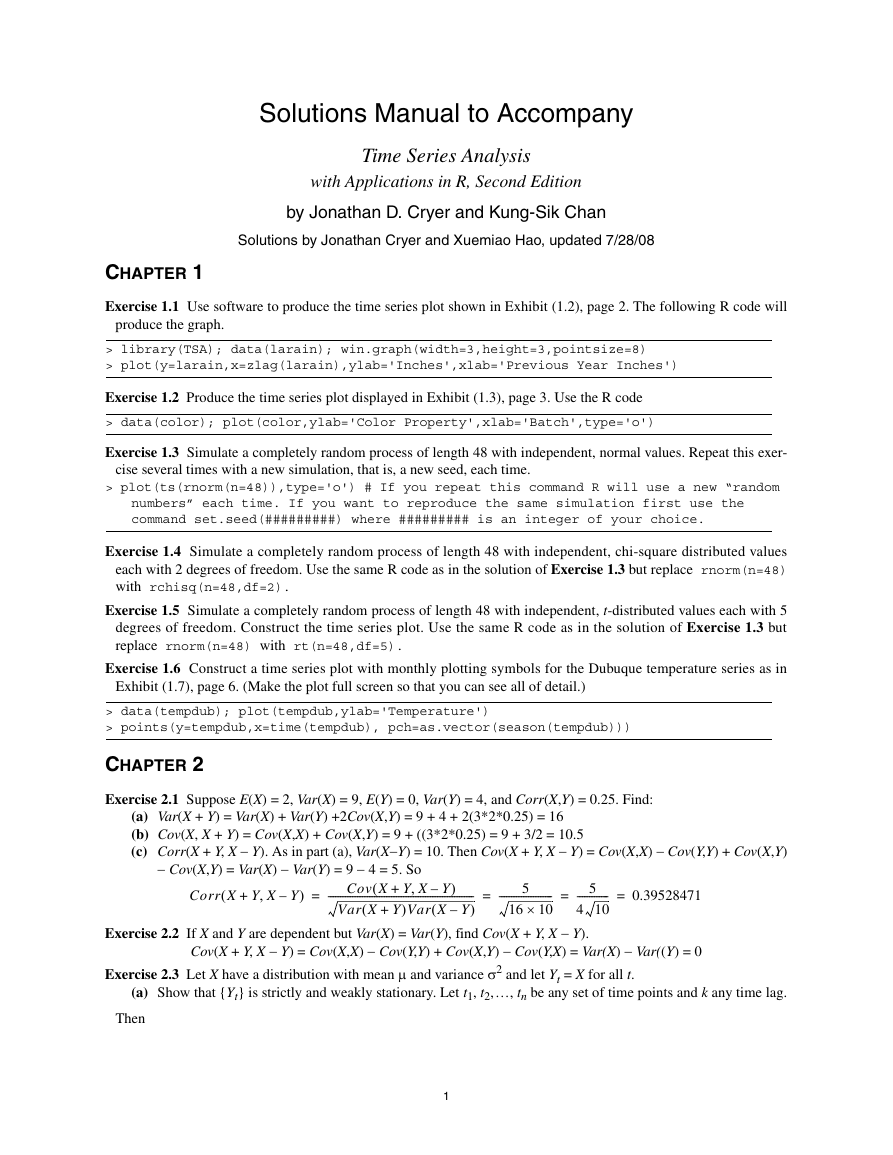
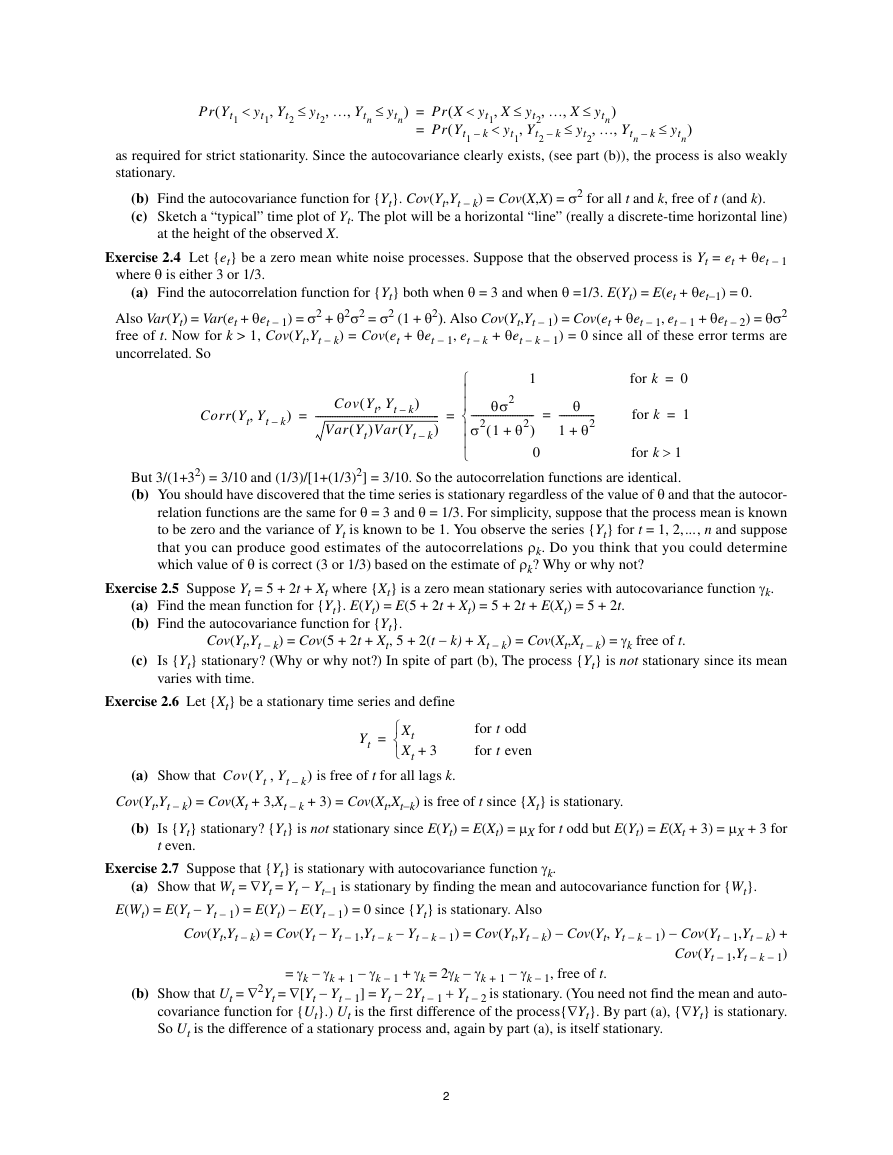
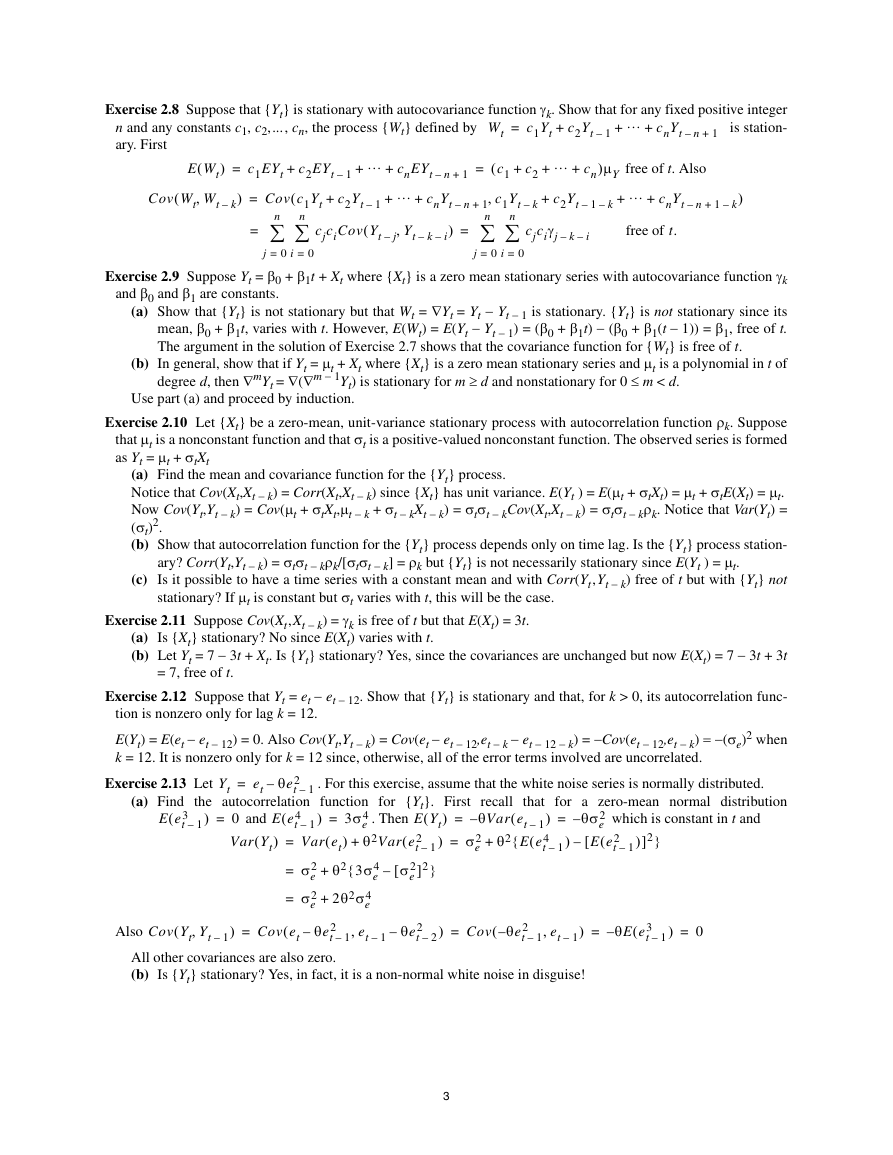
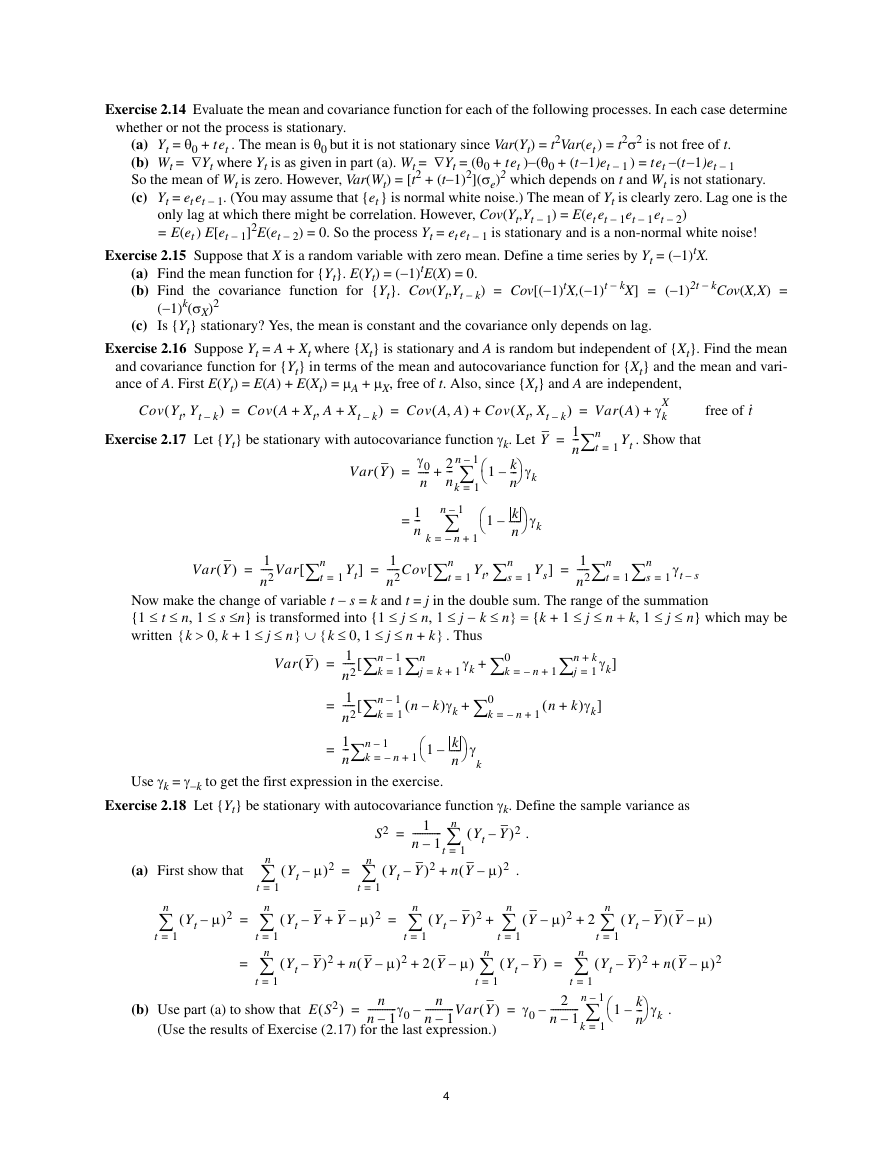
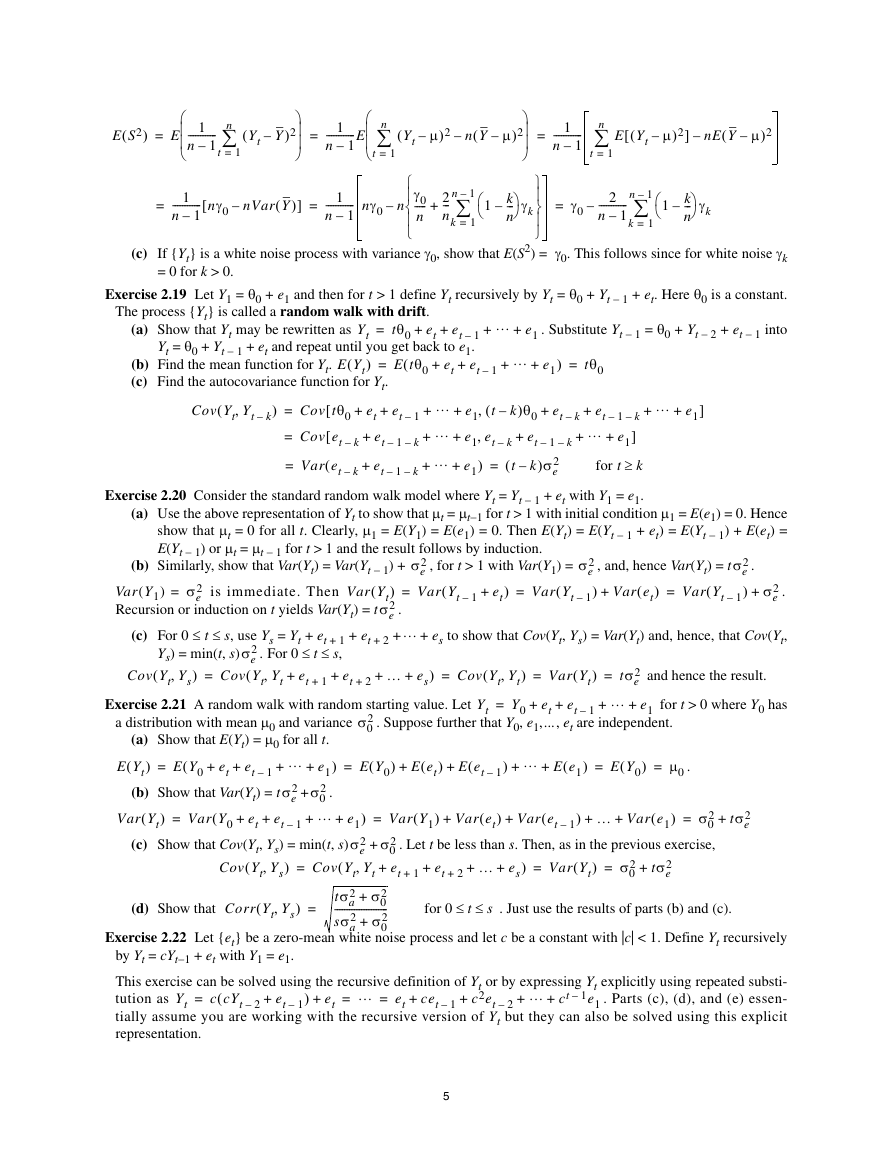
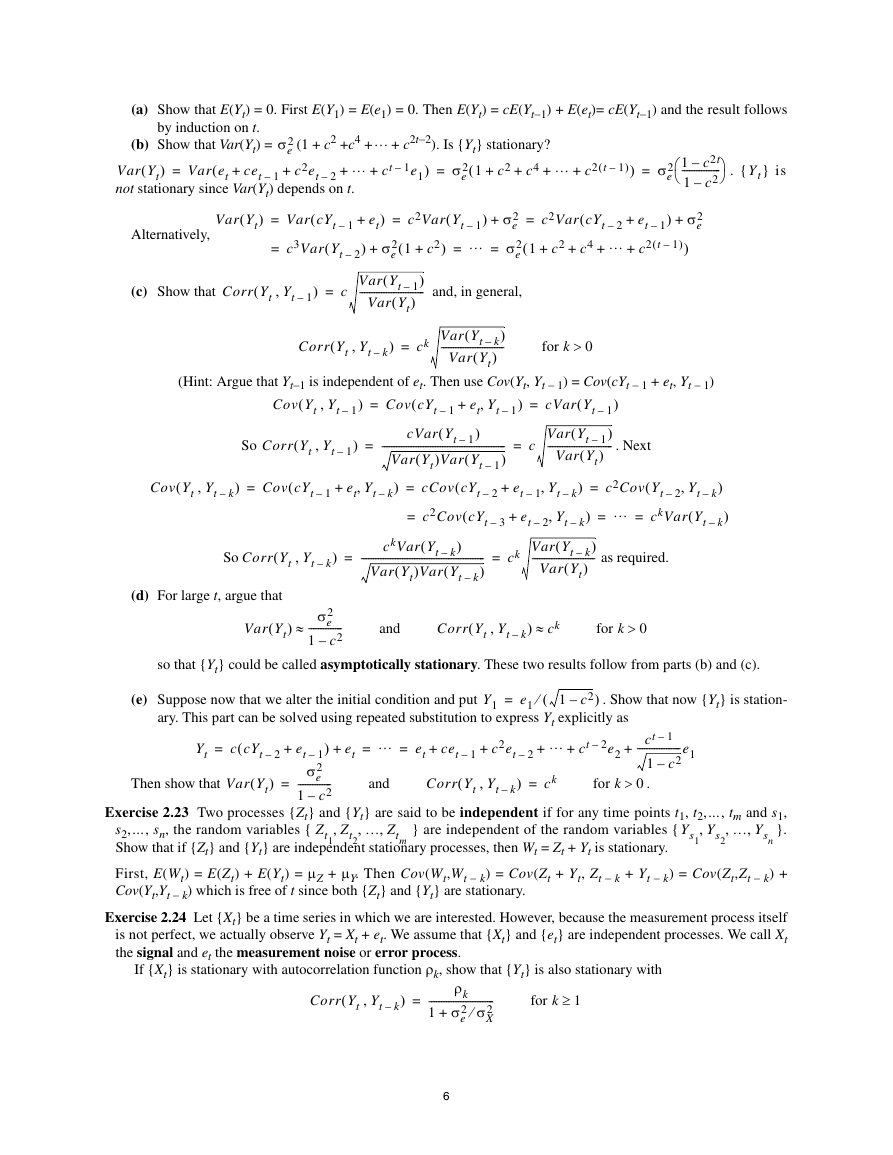
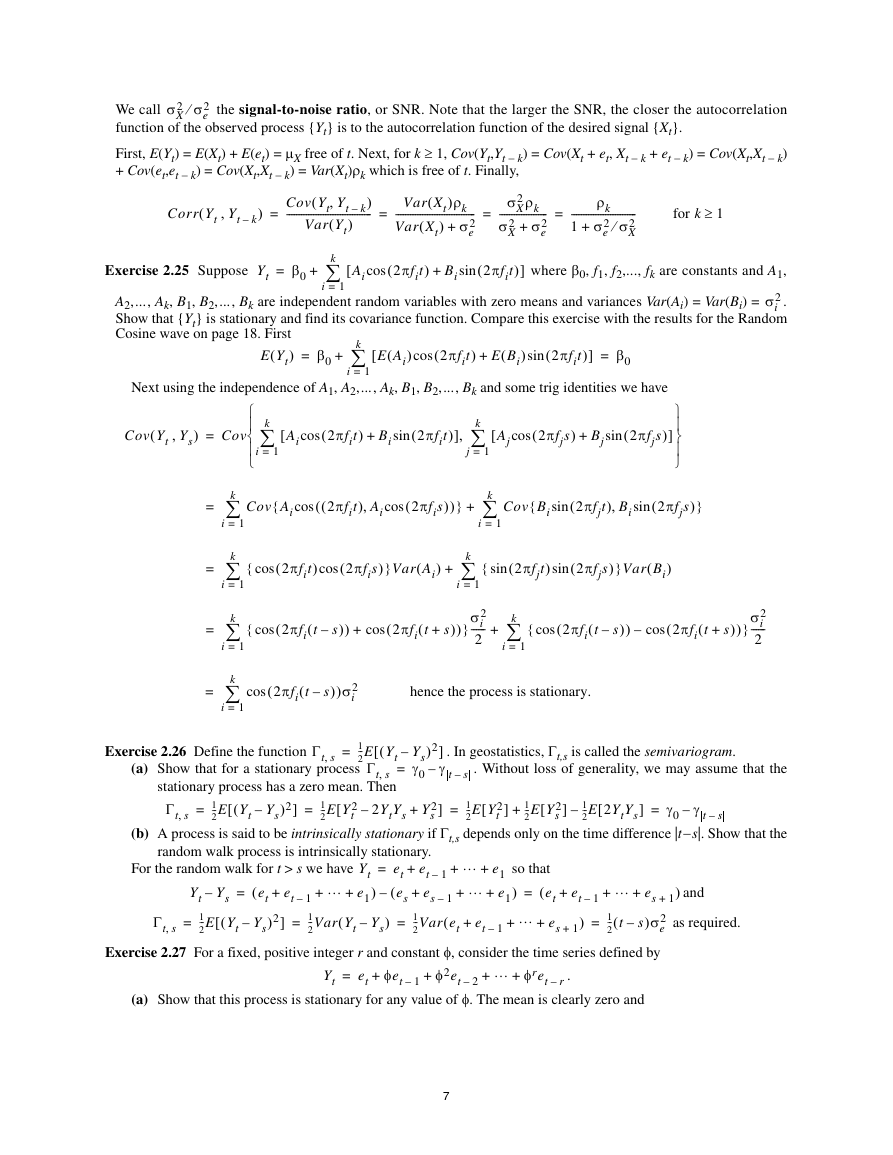
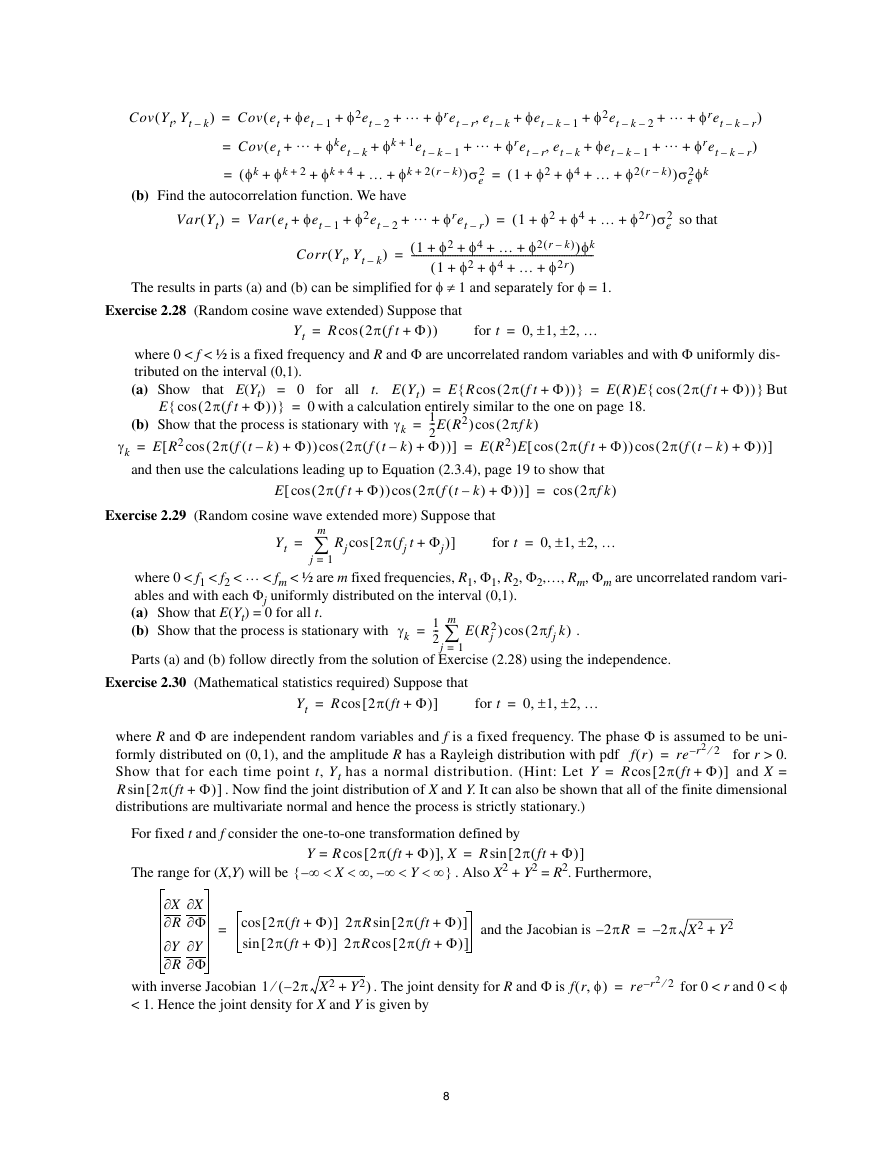








 2023年江西萍乡中考道德与法治真题及答案.doc
2023年江西萍乡中考道德与法治真题及答案.doc 2012年重庆南川中考生物真题及答案.doc
2012年重庆南川中考生物真题及答案.doc 2013年江西师范大学地理学综合及文艺理论基础考研真题.doc
2013年江西师范大学地理学综合及文艺理论基础考研真题.doc 2020年四川甘孜小升初语文真题及答案I卷.doc
2020年四川甘孜小升初语文真题及答案I卷.doc 2020年注册岩土工程师专业基础考试真题及答案.doc
2020年注册岩土工程师专业基础考试真题及答案.doc 2023-2024学年福建省厦门市九年级上学期数学月考试题及答案.doc
2023-2024学年福建省厦门市九年级上学期数学月考试题及答案.doc 2021-2022学年辽宁省沈阳市大东区九年级上学期语文期末试题及答案.doc
2021-2022学年辽宁省沈阳市大东区九年级上学期语文期末试题及答案.doc 2022-2023学年北京东城区初三第一学期物理期末试卷及答案.doc
2022-2023学年北京东城区初三第一学期物理期末试卷及答案.doc 2018上半年江西教师资格初中地理学科知识与教学能力真题及答案.doc
2018上半年江西教师资格初中地理学科知识与教学能力真题及答案.doc 2012年河北国家公务员申论考试真题及答案-省级.doc
2012年河北国家公务员申论考试真题及答案-省级.doc 2020-2021学年江苏省扬州市江都区邵樊片九年级上学期数学第一次质量检测试题及答案.doc
2020-2021学年江苏省扬州市江都区邵樊片九年级上学期数学第一次质量检测试题及答案.doc 2022下半年黑龙江教师资格证中学综合素质真题及答案.doc
2022下半年黑龙江教师资格证中学综合素质真题及答案.doc